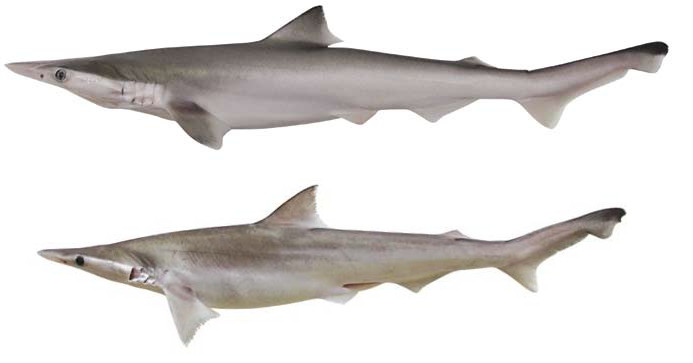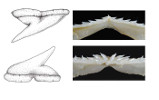Scoliodon macrorhynchos
(Bleeker, 1852)
Classification: Elasmobranchii Carcharhiniformes Carcharhinidae
Reference of the original description
Bijdrage tot de kennis der Plagiostomen van den Indischen Archipel. Verhandelingen van het Bataviaasch Genootschap van Kunsten en Wetenschappen, 24(art. 12): 1–92, Pls. 1–4
Bijdrage tot de kennis der Plagiostomen van den Indischen Archipel. Verhandelingen van het Bataviaasch Genootschap van Kunsten en Wetenschappen, 24(art. 12): 1–92, Pls. 1–4
Synonyms / new combinations and misspellings
Carcharias macrorhynchos, Carcharias (Scoliodon) macrorhynchos
Carcharias macrorhynchos, Carcharias (Scoliodon) macrorhynchos
Description :
Citation: Scoliodon macrorhynchos (Bleeker, 1852): In: Database of modern sharks, rays and chimaeras, www.shark-references.com, World Wide Web electronic publication, Version 01/2026
Please send your images of "Scoliodon macrorhynchos" to info@shark-references.com

Scoliodon macrorhynchos IPPS WWPLAL#1 adult male 426 mm TL, fresh and CSIRO H 7074–01 female 325 mm TL, fresh: lateral view; In: White, W.T. & Last, P.R. & Naylor, G.J.P. (2010): Scoliodon macrorhynchos (Bleeker, 1852), a second species of spadenose shark from the Western Pacific (Carcharhiniformes: Carcharhinidae). CSIRO Marine and Atmospheric Research Paper, 32: 61-76

Scoliodon macrorhynchos IPPS WWPLAL#1 adult male 426 mm TL, fresh and CSIRO H 7074–01 female 325 mm TL, fresh: lateral view; In: White, W.T. & Last, P.R. & Naylor, G.J.P. (2010): Scoliodon macrorhynchos (Bleeker, 1852), a second species of spadenose shark from the Western Pacific (Carcharhiniformes: Carcharhinidae). CSIRO Marine and Atmospheric Research Paper, 32: 61-76
Short Description
Diagnosis after WHITE, W.T. & LAST, P.R. & NAYLOR, G.J.P., 2010 [9062]: A small carcharhinid (to 71 cm TL) with the following combination of characters: a long and extremely flattened snout; slender body and tail; teeth smooth-edged with slender, strongly oblique, blade-like cusps and no cusplets; anterior teeth strongly sexually dimorphic with those of adult males greatly elongate and flexuous; total tooth row counts 25–28/23–28 rows or 48–56 total rows; second dorsal-fin origin well posterior of anal-fin origin, about opposite posterior third of anal-fin base; second dorsal-fin origin to analfin origin 6.0–9.1% TL, 1.3–2.5 times second dorsal-fin base; interdorsal space 17.9–22.2% TL; pelvic fins small, anterior margins 41–56% of pectoral anterior margin; first dorsal fin small, broadly triangular, origin behind pectoralfin free rear tips, free rear tip over posterior half of pelvicfin bases, length 12.9–15.5% TL, inner margin 2.1–3.0 in base; second dorsal fin very small, base 2.0–3.5 times height; height 18–27% of first dorsal-fin height; anal fin large, length 11.1–14.1% TL, height 1.7–2.5 times second dorsal-fin height, base 1.9–3.1 times second dorsal-fin base; total vertebral count 149–171, monospondylous precaudal count 44–50, diplospondylous precaudal count 53–64, diplospondylous caudal count 49–59, precaudal count 98–114; colour greenish-bronze dorsally, off white ventrally when fresh; when preserved, slate-grey dorsally, whitish ventrally with waterline clearly demarcated along head, more diffuse along body, no distinct black spots on fins.
Diagnosis after WHITE, W.T. & LAST, P.R. & NAYLOR, G.J.P., 2010 [9062]: A small carcharhinid (to 71 cm TL) with the following combination of characters: a long and extremely flattened snout; slender body and tail; teeth smooth-edged with slender, strongly oblique, blade-like cusps and no cusplets; anterior teeth strongly sexually dimorphic with those of adult males greatly elongate and flexuous; total tooth row counts 25–28/23–28 rows or 48–56 total rows; second dorsal-fin origin well posterior of anal-fin origin, about opposite posterior third of anal-fin base; second dorsal-fin origin to analfin origin 6.0–9.1% TL, 1.3–2.5 times second dorsal-fin base; interdorsal space 17.9–22.2% TL; pelvic fins small, anterior margins 41–56% of pectoral anterior margin; first dorsal fin small, broadly triangular, origin behind pectoralfin free rear tips, free rear tip over posterior half of pelvicfin bases, length 12.9–15.5% TL, inner margin 2.1–3.0 in base; second dorsal fin very small, base 2.0–3.5 times height; height 18–27% of first dorsal-fin height; anal fin large, length 11.1–14.1% TL, height 1.7–2.5 times second dorsal-fin height, base 1.9–3.1 times second dorsal-fin base; total vertebral count 149–171, monospondylous precaudal count 44–50, diplospondylous precaudal count 53–64, diplospondylous caudal count 49–59, precaudal count 98–114; colour greenish-bronze dorsally, off white ventrally when fresh; when preserved, slate-grey dorsally, whitish ventrally with waterline clearly demarcated along head, more diffuse along body, no distinct black spots on fins.
Distribution
Occurs in the Western Central Pacific; recorded from western Indonesia, Malaysia, Gulf of Thailand, Singapore, Borneo, Philippines, China, Hong Kong, Taiwan and Japan [9062] Source: www.gbif.org
Occurs in the Western Central Pacific; recorded from western Indonesia, Malaysia, Gulf of Thailand, Singapore, Borneo, Philippines, China, Hong Kong, Taiwan and Japan [9062] Source: www.gbif.org
Remarks
shark-references Species-ID=9009;
shark-references Species-ID=9009;
Parasites (arranged by Jürgen Pollerspöck)
Cestoda
Cestoda
- Otobothrium carcharidis (Shipley & Hornell, 1906) [21816]
- Phoreiobothrium waeschenbachae Caira, Bueno & Jensen, 2025 [35028]


















